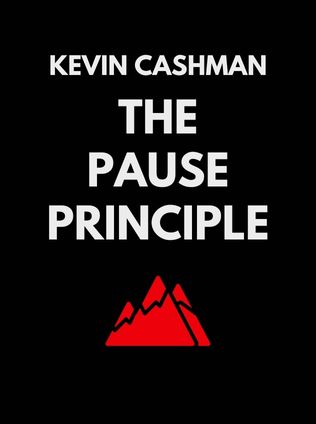
The Pause Principle
Step Back to Lead Forward
By Kevin Cashman
Published 10/2012
About the Author
Kevin Cashman is a senior partner in Leadership and Talent Consulting at Korn/Ferry International. He is also the founder of the Chief Executive Institute and a senior fellow of the Caux Roundtable. His expertise in leadership development has made him a respected figure in the field, and his work has helped many organizations and leaders achieve greater clarity, purpose, and performance. Cashman is the author of several influential books, including The Pause Principle: Step Back to Lead Forward, which advocates for a transformative approach to leadership through intentional pauses.
Main Idea
The Pause Principle by Kevin Cashman posits that in today’s fast-paced, volatile world, leaders need to pause to lead effectively. This counterintuitive approach involves stepping back to gain clarity, fostering personal growth, developing others, and creating a culture of innovation. By integrating pauses into their routines, leaders can transform their performance and achieve sustainable success.
Table of Contents
- Introducing the Pause Principle
- Flipping the VUCA Forces
- Creating a New Normal
- Step Back to Lead Forward: Seven Pause Practices
- Pause to Grow Personal Leadership
- Pause to Grow Others
- Pause to Grow Cultures of Innovation
- Three After Words: Pause It Forward
Introducing the Pause Principle
Cashman introduces the idea that, like sleep rejuvenates the body and mind, pauses rejuvenate leadership and innovation. In a world characterized by volatility, uncertainty, complexity, and ambiguity (VUCA), leaders are often tempted to accelerate their actions. However, Cashman argues that meaningful progress comes from intentional pauses, allowing leaders to connect deeply with their purpose and make more impactful decisions.
"Pause transforms management into leadership and the status quo into new realities." - Kevin Cashman
The Pause Principle is a process of stepping back to lead forward with greater clarity and purpose. It involves three critical growth areas: strengthening personal leadership, developing others, and fostering cultures of innovation. By embracing this principle, leaders can transform their approach to management and achieve significant, lasting impact.
Flipping the VUCA Forces
The concept of VUCA, borrowed from the Army War College, describes the chaotic environment leaders operate in today. Cashman suggests flipping these forces to bring about Vision, Understanding, Clarity, and Agility. This transformation is achieved through the power of pause, helping leaders sort through complexity and connect with what truly matters.
In our fast-paced, 24/7 connected world, the incessant drive for more action and speed often leads to burnout and diminished leadership capacity. Cashman emphasizes that by pausing, leaders can gain a fresh perspective, identify core issues, and develop innovative solutions. This approach contrasts with the traditional notion that leaders must always be in motion, demonstrating that sometimes the best way to move forward is to step back and reflect.
Creating a New Normal
Pause is a natural, inherent principle that leads to growth and innovation. By consciously integrating pauses, leaders can lead with greater authenticity and purpose. This practice involves stepping back both internally and externally to gain a broader perspective and align actions with deeper values.
Sign up for FREE and get access to 1,400+ books summaries.
You May Also Like
The Subtle Art of Not Giving a F*ck
A Counterintuitive Approach to Living a Good Life
By Mark MansonRich Dad Poor Dad
What the Rich Teach Their Kids About Money - That the Poor and Middle Class Do Not!
By Robert T. KiyosakiHow To Win Friends and Influence People
The All-Time Classic Manual Of People Skills
By Dale CarnegieQuiet: The Power of Introverts
The Power of Introverts in a World That Can't Stop Talking
By Susan Cain



















